We started our New Zealand tour on the North Island. If you’re visiting our website for the first time and want to know how to plan a complete tour in New Zealand, check out our tips in the post New Zealand: a trip through this amazing country.
Although New Zealand’s most beautiful landscapes are on the South Island, the North Island is also full of impressive places. And I can say that I regret not having dedicated more time to this region.
Our initial idea was to make a Rotorua-Hobbiton-Waitomo-Taupo-Tongariro tour in 5 days, and leave the region called ‘Northland‘ – the northern tip of the North Island – for the end of the trip, as we would return to Auckland to pick up the flight back. However, we ended up extending our time in South Island, and as a result Auckland and Northland were hampered on this trip.
Going back to the first part of the plan…it was 5 days in 5 different places. To avoid having to change accommodation several times, we used 2 cities as a base: Rotorua and Taupo.
Rotorua
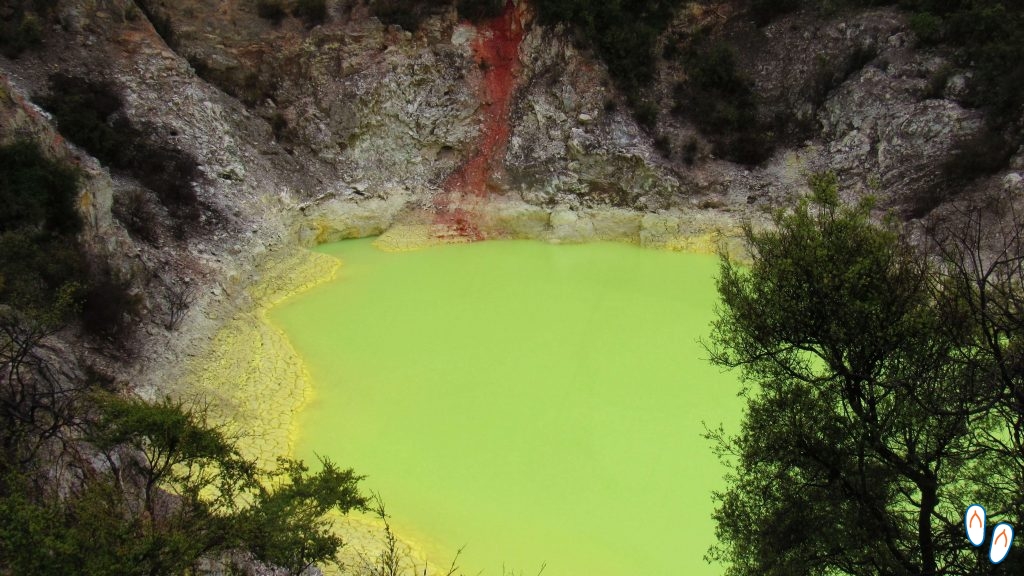 Devil’s Bath, glow yellow sulfuric lake in Wai-O-Tapu, Rotorua, North Island of New Zealand
Devil’s Bath, glow yellow sulfuric lake in Wai-O-Tapu, Rotorua, North Island of New Zealand
In Auckland airport, we rented a car at Apex rental company and drove 220km towards Rotorua, where we stayed in a house rented by AirBnb.
Rotorua is an excellent place to use as a base. It’s a well-structured city, and is within walking distance of several tours that can be done on the North Island.
The only bad luck we faced was the weather during our trip on the North Island. That’s because we landed in New Zealand practically next to a cyclone that came from Australia and accompanied us for a few days in the region. We were forced to change the schedule and stay inside the house for a full day, unable to do anything we planned.
What to do in Rotorua
Rotorua’s main attractions are the hot springs with geysers and pools of boiling water colored by different minerals. The city of Rotorua is right on top of the Pacific Ring of Fire and therefore has one of the most active fields of geothermal activity in the world.
To get a closer look at the effects of this geothermal activity, we went to visit the thermal parks Wai-O-Tapu and Te Puia.
Wai-O-Tapu
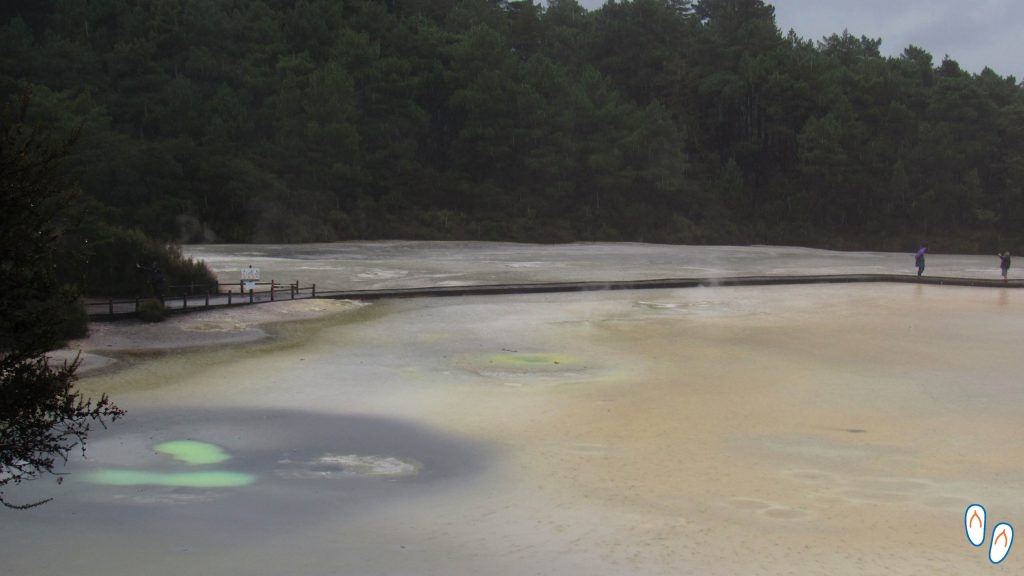 Wai-O-Tapu Thermal Wonderland Park in Rotorua, North Island of New Zealand
Wai-O-Tapu Thermal Wonderland Park in Rotorua, North Island of New Zealand
At Wai-O-Tapu Thermal Wonderland, we paid NZD 32.50 to enter. The visitor walks along a wooden walkway from where one can see several hot springs with different colors and shapes. The water reaches very high temperatures and it is not allowed to enter or even to touch the pools.
One of the most impressive formations in Wai-O-Tapu is the Champagne Pool. The Champagne Pool was formed about 700 years ago by a hydrothermal eruption and the crater reaches a depth of up to 62 meters. This thermal pool has greenish water with an orange border due to the presence of minerals such as arsenic and antimony. The temperature of the water entering from below can reach 230⁰C, while on the surface it is usually 75⁰C.
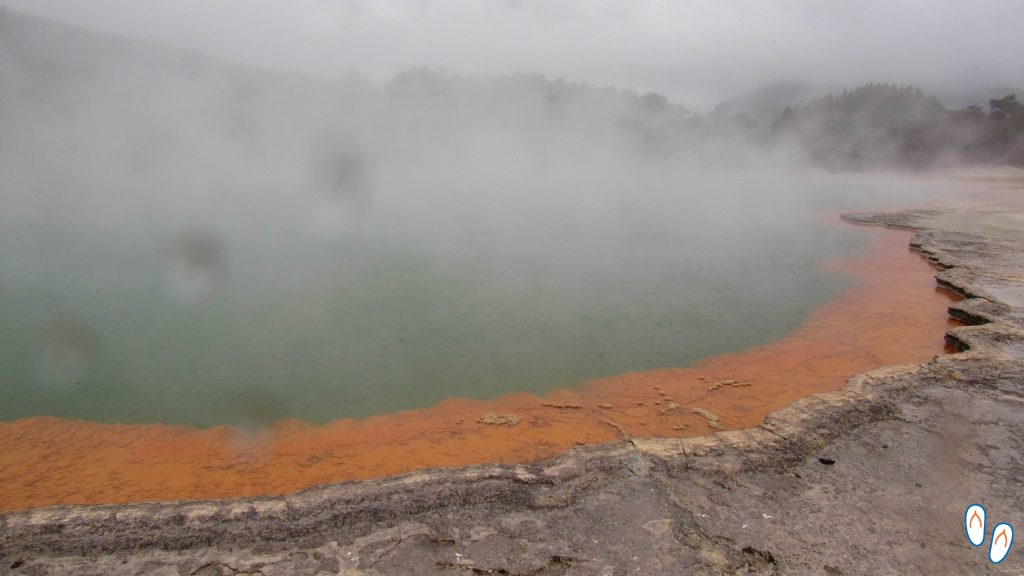
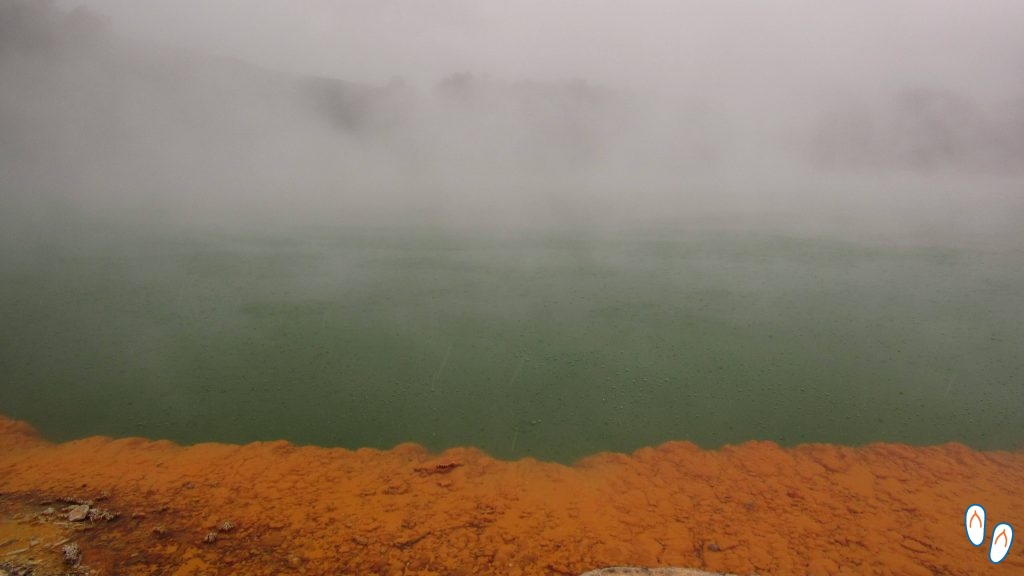 Champagne Pool, in Wai-O-Tapu. The steam is strong – and the smell too!
Champagne Pool, in Wai-O-Tapu. The steam is strong – and the smell too!
Still in Wai-O-Tapu, the Lady Knox geyser is another place that usually attracts many visitors due to the strong eruption of water and steam that happens daily and reaches up to 20 meters in height. The Lady Knox eruption occurs in an induced way, that is, it is artificially stimulated. Despite this, it is quite impressive to watch the jet of water rising furiously in the air.
Te Puia
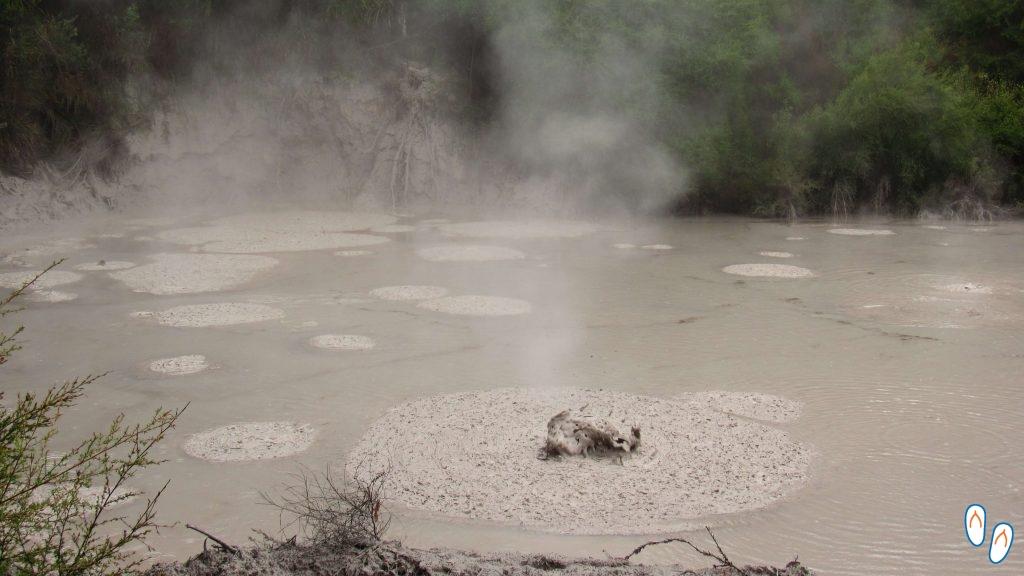 “Mud Pools” – boiling mud pools in Te Puia – are fun to watch.
“Mud Pools” – boiling mud pools in Te Puia – are fun to watch.
As a thermal park, Te Puia is also very interesting. Despite not having the vibrant colors in the thermal pools as in Wai-O-Tapu, you can watch the bubbling mud pools and see the erupting Pohutu geyser. Pohutu is considered the most active geyser in the southern hemisphere. Its eruptions are natural and happen several times a day.
But Te Puia is not just a thermal park. One of the biggest attractions of the place is to be a reference for those who want to know more about the Maori culture, the native people of New Zealand.
The Te Puia day tour – which they call Te Rã – costs NZD 54.00 per adult and includes access to the New Zealand Maori Arts & Crafts Institute, where Maori-style sculptures are made; and to a replica of the Maori village, as a way of teaching visitors about the habits and culture of these people.
The night tour sold at the park – Te Põ – has a Maori banquet as its main attraction, accompanied by a show with Maori dances and clothing. The night tour is sold at NZD 125.00 in the park. It seemed to us something very “touristic”, but it is still a way to learn more about culture for those who are interested.
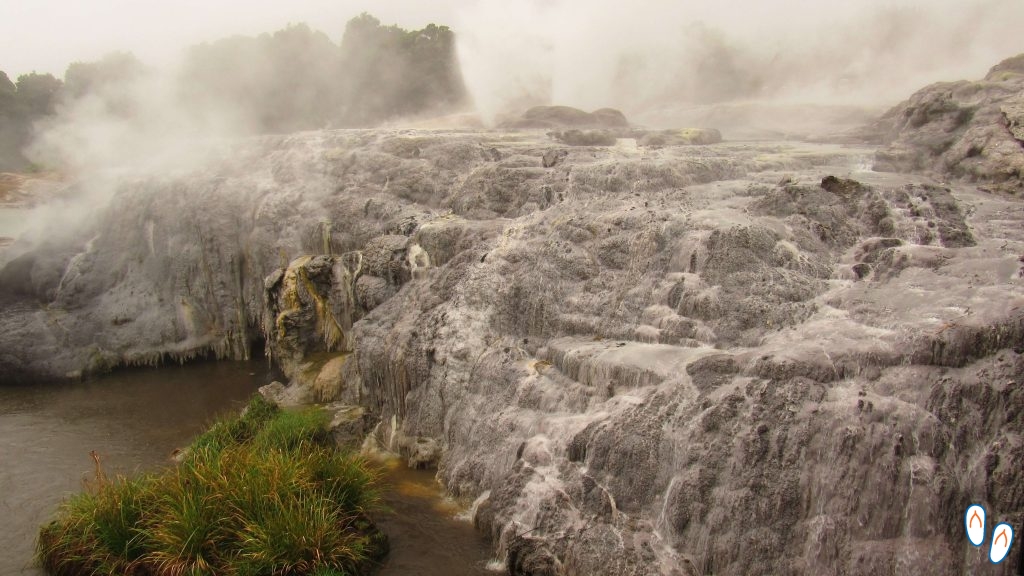 Te Puia, Rotorua, North Island of New Zealand
Te Puia, Rotorua, North Island of New Zealand
Other geothermal parks
Also for those who enjoy observing the geothermal areas, there is the Waimangu Volcanic Valley, a park where the Frying Pan Lake and the Inferno Crater Lake attractions are located.
Frying Pan Lake is currently the largest hot water pool in the world. Its acidic water is kept at a temperature of 50⁰ to 60⁰C. Inferno Crater Lake is a higher lake with a very light blue color, and formed by an underground geyser that is not visible on the surface.
The Waimangu Volcanic Valley is about 4km long and admission costs NZD 40.00 per person. The park also offers a 45-minute boat ride across Lake Rotomahana for NZD 45.00.
For those who prefer a more sensorial experience, the thermal SPAs like Hell’s Gate, the Polynesian Spa and the Waikite Valley Thermal Pools can be great alternatives. At the SPAs the main idea is to relax in the thermal pools.
There are also some options of free places where you can visit and even enter the thermal stations. At the Backpacker Guide blog you can find out more about these options.
Other activity options in Rotorua
Although famous for its parks with geothermal activity, Rotorua also offers other options for activities.
One of the most famous is the Whakarewarewa Forest, also known as Redwoods. It is a forest of more than 5500 hectares full of Sequoias where visitors practice mountain biking and trails/hikes. The access to the park is free, and the visitor only pays NZD 25.00 for the treewalk.
In addition to the Whakarewarewa Forest, other activity options in Rotorua include Swing Jumping, Bungee Jumping, Jetboat ride, rafting, Luge Run, Zip line, gondola rides, among others. More information on New Zealand’s official tourism website.
Hobbiton
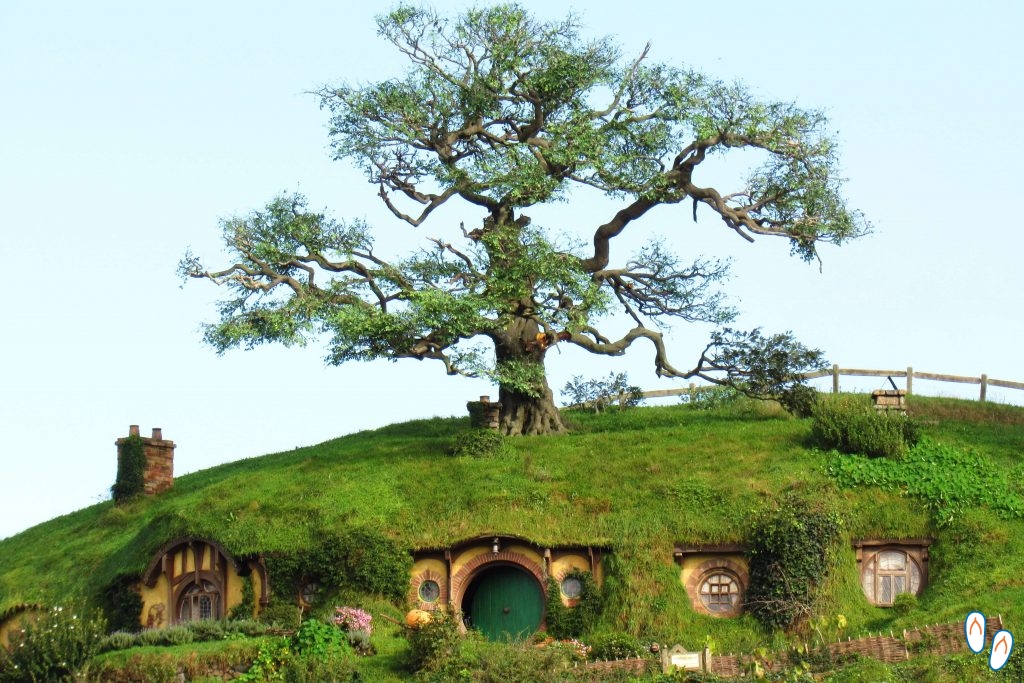
In my opinion, you don’t even have to be a big fan of The Lord of the Rings to want to visit one of the biggest and most iconic sets of the film – The Shire. Hobbiton is impressive for its general structure (which is immense), for the magic and richness of details, and of course, for the beauty that is characteristic of where the Hobbits live.
The set that is found today in the Hobbiton Movie Set park was actually set up for The Hobbit triology. For The Lord of the Rings triology, a structure was used in the same place, but it was a temporary one. However, the franchise was so successful that it created a demand among fans who wanted to “live” the experience of being inside the film.
As a result, Peter Jackson, when deciding to shoot J.R.R.Tolkien‘s The Hobbit, created a definitive movie set in Hobbiton that became an interesting place to visit for LOTR fans.
How to get to Hobbiton

Hobbiton is located in the city of Matamata. As we were staying in Rotorua, it took us just over 1h to arrive. For those who are not driving, the park offers transportation to the site.
The price for the regular tour in 2018 is NZD 84.00 per adult – and that amount may include the transfer of Matamata, for those who need it. However the price of the ticket with transfer from Rotorua rises to NZD 119.00.
It’s important to book tickets in advance. Each tour has a scheduled time and those who doesn’t buy the tickets previously can risk getting only the last tours of the day, or finding all tickets for the day sold-out.
How is the Hobbiton tour
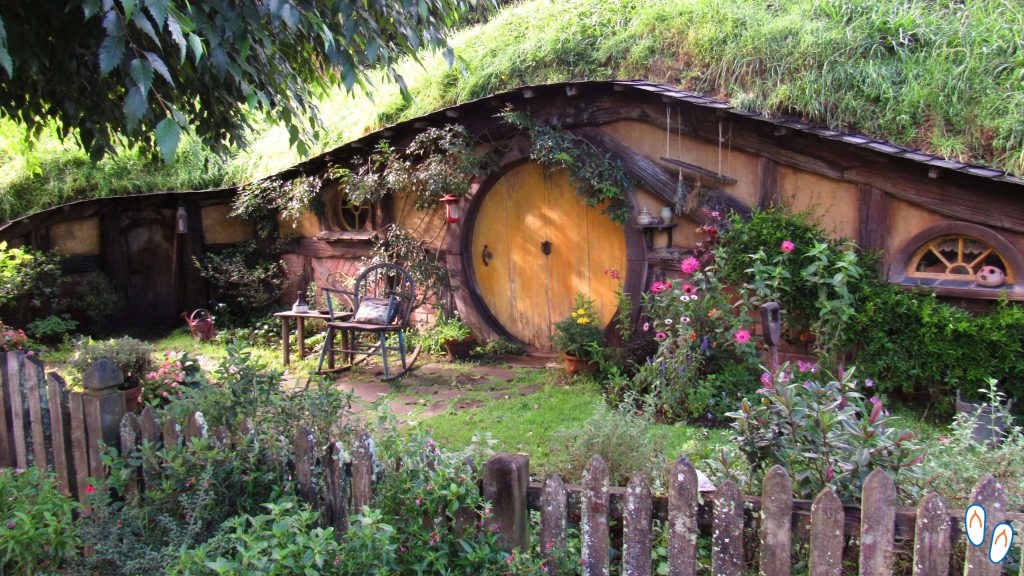
It’s worth checking the park’s website to see all the tour options. Tickets must be purchased on this same website.
The regular tour lasts an average of 2 hours, in a large group, with an introduction of the place and a tour throughout the set. The visitor passes in front of the house of several Hobbits. You literally feel like you’re in the movie. The scenery is only external, it is not allowed to enter the houses.
At the end of the tour, visitors are invited to have a typical Middle-earth drink at Green Dragon, the bar frequented by Hobbits in the story.
The park also offers other tour options, such as combos, private tours and special events. One of the options that may interest the most enthusiastic fans – unfortunately we didn’t get to do it – is the Evening Banquet Tour.
On the Evening Banquet Tour the visitor travels the Shire at night, with the houses lightened, and participates in a generous banquet at the Green Dragon, where you will have the chance to eat like a Hobbit.
The Evening Banquet takes place only a few days a week, and they are very busy, as vacancies are limited. The price (in 2018) was NZD 195.00 per adult and it is necessary to book in advance.
Waitomo
We went from the magical city of the Hobbits straight to Waitomo, where the famous Glowworm Caves are located.
What are Glowworm Caves?

Those little bright blue dots (which are the only ones we were able to register with our camera) are worms! The worm, scientifically named Arachnocampa Luminosa, popularly called the glowworm, is endemic to New Zealand, and inhabits humid caves, such as those of Waitomo.
The animal emits a strong blue light both as a larva and as an adult.
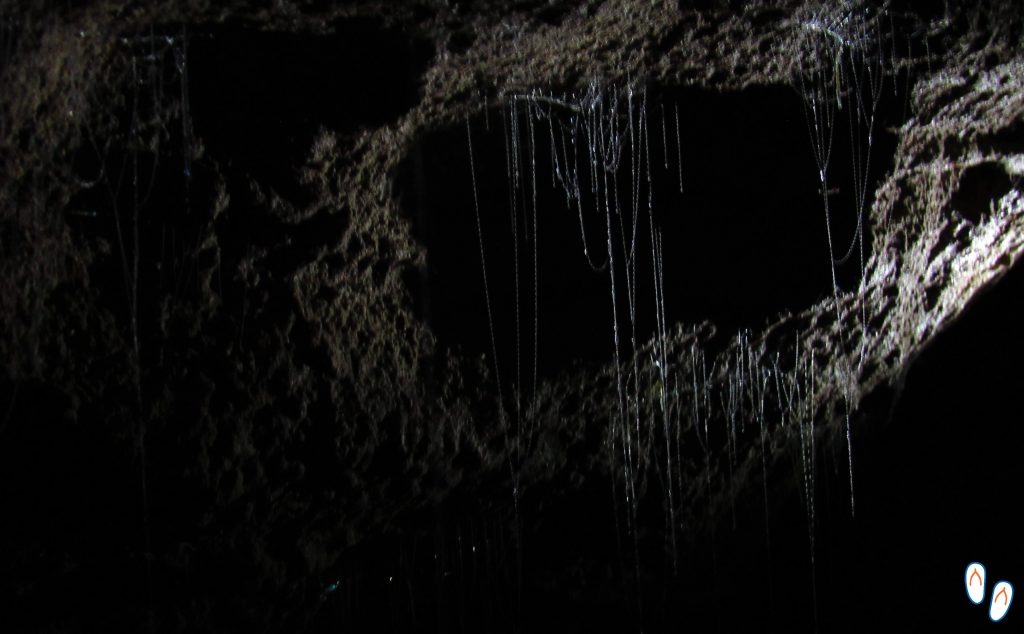
The tour options offered by Waitomo Glowworm Caves are:
- Ruakari Cave (NZD 74.00/adult) – Walking tour of approx. 2 hours by a metal walkway where you can observe the glowworms and the impressive cave formations up close like the stalactites. Photo cameras are allowed.
- Aranui Cave (NZD 50.00/adult) – Walk of about 1 hour inside the Aranui cave to observe stalactites, stalagmites and other “decorative” formations. This tour also includes a 15-minute walk outside the cave. Photo cameras are allowed.
- Waitomo Glowworm Caves (NZD 51.00/adult) – A 45-minute tour that includes a walk to see large geological formations and the Cathedral, which is the largest cave in height, where the acoustics are excellent, and where even musical concerts have already taken place. This tour also includes a part made by boat, passing the course of the Waitomo River, where the only lighting comes from the glowworms on the roof of the cave, making it look like a sky with bluish stars. It is not allowed to take any type of camera on this tour.
- Black Labyrinth (NZD 142.00 / adult) – Activity of about 3 hours that includes a rafting inside the cave. The visitor floats down a river that passes inside Ruakuri Cave with a rubber buoy, while watching the glowworms lighting on the cave ceiling. Basic equipment is included. Photo cameras are not allowed. Activity allowed for people aged 12 and over.
- Black Abyss (NZD 246.00 / adult) – Activity of about 5 hours for those looking for more radical experiences. Black Abyss is the most adventurous option inside the Waitomo Caves. This activity includes abseiling, climbing, zip lining, rafting, waterfalls, and, of course, the glowworms. Minimum age 16 years.
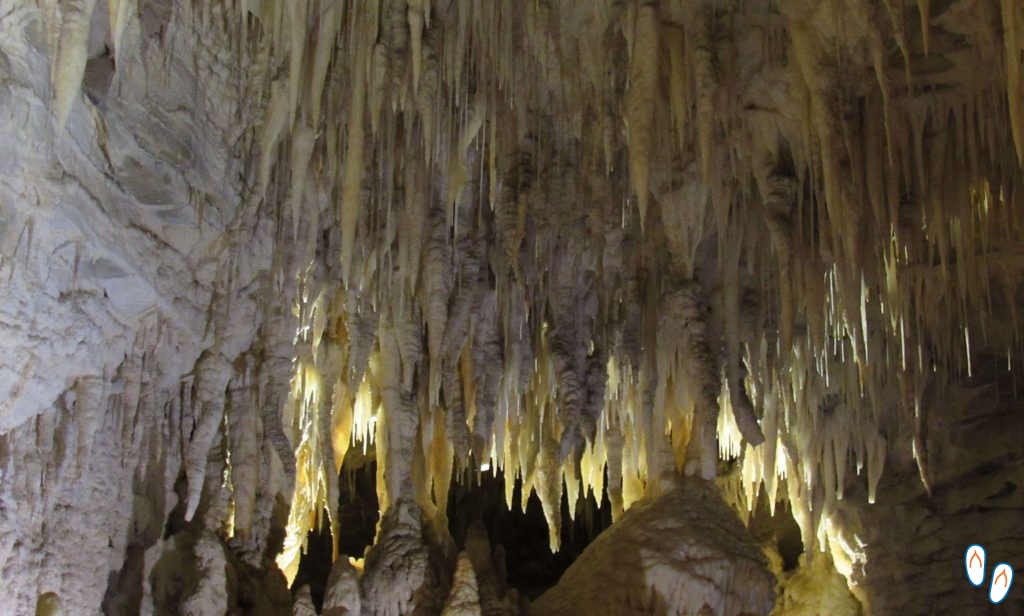 Ruakari Cave, where geological formations and glowworms are observed.
Ruakari Cave, where geological formations and glowworms are observed.
We were determined to take the Waitomo Glowworm Caves tour, but due to availability, we ended up taking the Ruakari Cave tour, where you can also see a lot of glowworms, but the tour is done on foot instead of going on a boat. It was worth it, it’s something very different to see and the internal formations are also very impressive. The advantage of being able to take your camera will only make a difference if the camera is good for night shots.
Purchasing and scheduling can be done in person on site or on the website, where you can also find more details about all the available tours. I highly recommend that you make the purchase in advance to guarantee the tour of your preference.
In addition to individual tours, the company offers several combos such as Trilogy and Wet Hair Deals, in which the visitor combines more than one tour for a promotional price.
Taupo
Taupo is an important city on the North Island of New Zealand and it is the place we chose to use as a base to visit Lake Taupo and to do the Tongariro Alpine Crossing trail.
Lake Taupo is the largest lake in New Zealand. Its origin comes from a huge volcano that occupied its area.
Lake Taupo is used for several activities. One of its most touristic spots is Mine Bay, where you will find a 10 meter high Maori sculpture created by the master sculptor Matahi Whakataka-Brightwell in the 70s.
For those who practice mountain biking, you may want to take the Great Lake Trail. The Great Lake Trail is 71km in total and is an intermediate level bike trail. It can be done in parts but it is more recommended for people with experience in mountain biking. The trail passes through Lake Taupo, as well as through a forest area and beautiful viewpoints. More information on the website.
Another popular place to visit is called Huka Falls. Huka Falls is a set of waterfalls on the Waikato River, a few kilometers from Lake Taupo, where the volume of water reaches more than 220,000 liters per second.
The impressive and turbulent fall can be seen on foot – a few meters from the parking lot of Huka Falls Road, where there’s also a trail to follow the course of the river – or by a jetboat ride.
Unfortunately we didn’t have time to visit the attractions of Taupo. Due to the cyclone that arrived on the island with us, we extended our stay in Rotorua and reduced our time in Taupo from 2 days to 1 day. This 1 day we used to do the Tongariro Alpine Crossing.
Tongariro Alpine Crossing
Tongariro National Park (or Mordor, for Lord of the Rings fans) is one of the main landscapes in New Zealand. The park is right in the center of the North Island and its extension is 786km2. Its volcanic landscape with light blue lakes is one of New Zealand’s postcards.
Tongariro Alpine Crossing is perhaps the most famous trail in the kiwi country. The trail is 19km long, covering the distance between Mangatepopo and Ketetahi, and it usually takes 8 hours to be completed.
The park is open 24 hours a day, and doesn’t charge any visitation fee. The trails can be done without the accompaniment of a tour guide. The visitor can decide what direction he wants to take in the trail, but the most usual one leaves from Mangatepopo because it’s the highest side and therefore makes the trail less tiring.
How to get to Tongariro
The trail starts and ends at 2 parking places. There is no public transport to these points, so you must hire a private transfer to take you to these places.
How we did it: we drove the car to the end of the trail – Ketetahi Car Park – and from there we took a transfer – which must be scheduled in advance – to the starting point – Mangatepopo.
There are several companies that provide the shuttle service, so you should always pay attention to taking the right bus. We hired Mountain Shuttle, which costed NZD 30.00 per person. The purchase was made via website the day before, and we were lucky to get available places. We took the 6:00 am bus.
You can also check with other companies, including the National Park Shuttle. The bus takes almost 1h to reach the starting point of the trail.
How is the Tongariro Alpine Crossing trail
The first thing you need to know about Tongariro Alpine Crossing is that weather conditions can change suddenly and that it can go to extremes.
Based on other people’s experiences, my biggest fear was to get extreme heat and dehydration. Knowing that the trail is long and demanding, with high elevation, our first concern was to take with us a lot of water and food.
Ironically, our problem was exactly the opposite: on the day of the trail, it was very foggy, windy, rainy and cold. The temperature inside the park was close to 0⁰C.
Right at the beginning of the trail, we noticed more people coming back than going. “There are always people who can’t take it”, I thought. But that continued for all the 6km that we traveled towards Ketetahi. The further we went, the more people we passed by coming back warned us: “Don’t even insist, you can’t pass”.
Our insistence was largely due to the chances of weather sudden changes. We left early in the fog, but the weather could open during the day. But the rain and wind were only getting worse. And practically everyone was coming back.
The trail, as far as we could tell, was not so difficult to complete. But some parts in particular require more attention and can be quite dangerous in bad weather. And, especially, if you’re not wearing clothes that keep you dry and comfortable, this can be a problem.
Long story short: we walked for 6km until common sense won over stubbornness and we decided to go back to the starting point.
Mountain Shuttle had informed us that they put buses available, making the journey back for those who do not complete the trail. On that particular day, considering the number of people who returned, there were extra buses – also from other companies. Fortunately, we didn’t have to wait so long for the bus. In short time we were back in the car, where we had left towels and managed to get warm.
The desire to finish the trail was big. But we had to be reasonable and realize that the fog would even keep the beautiful landscape hidden to our eyes. Maybe next time!
Anyway, here are some tips that I find useful for those who are about to venture into Tongariro Alpine Crossing:
- Plan your trip to New Zealand considering a few days off, and stay updated with the weather forecast to choose a good day to do the Tongariro Alpine Crossing;
- As usual for this type of trail, dress yourself like an “onion”: wear several layers, have heavier clothes to keep warm in the cold, lighter clothes for the heat, and on top an impermeable layer for rain;
- Wear a good, comfortable and stable shoe, preferably a waterproof trekking boot to keep your feet dry;
- If you go hiking in the winter, be aware that you can find ice and snow on the trail. In that case, consider hiking with an agency, such as Adventure Outdoors Tongariro.
- Take enough food and water, sunscreen, gloves, cap and sunglasses;
- Know how to assess climatic conditions and respect your limits;
- Be prepared to return if the visibility is very bad, or if there are very strong winds;
- Start the trail early to be more advanced when the sun gets stronger;
- Download the Tongariro Alpine Crossing app to learn more about each section of the trail. The application shows information such as the highest elevation points, location of bathrooms and an offline map;
- There is no cell phone signal in the middle of the trail;
- The trail is usually quite busy; even so, avoid doing the Tongariro Alpine Crossing alone;
- There are no sources of drinking water in the trail and very few bathrooms;
- Take some type of protection for electronic equipment in case of rain.
Despite all the physical challenges and climatic instability, for those who enjoy hiking, I think it is very worthwhile. We unfortunately didn’t get to see the beauty of Tongariro National Park this time, but we know it is a unique landscape. If you have already been there, tell us on the comments section how your experience was!




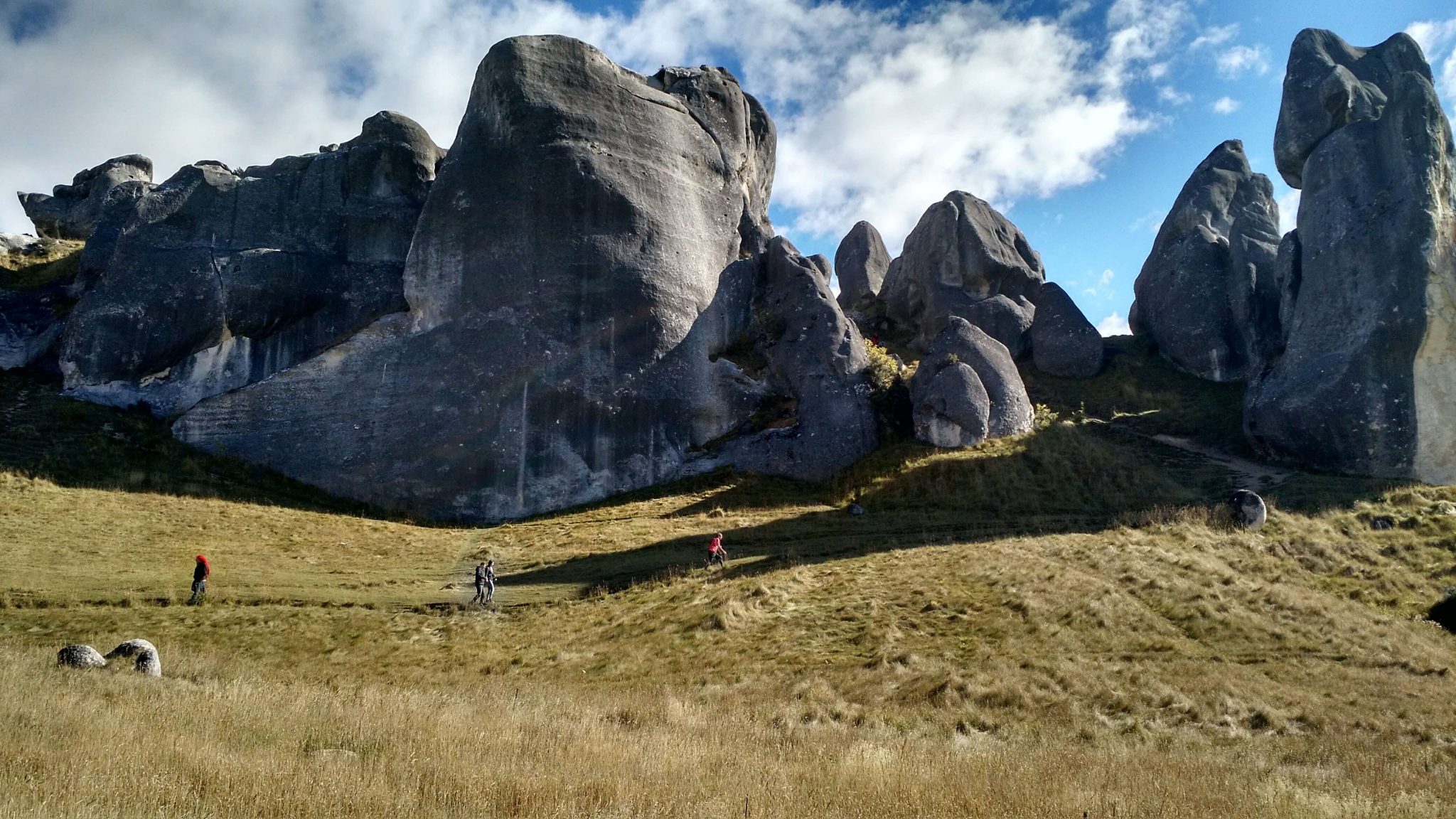
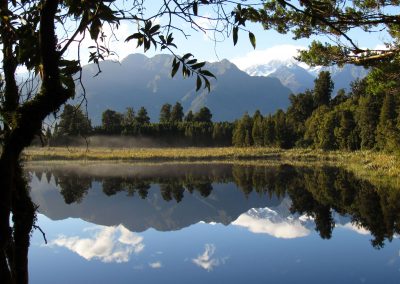
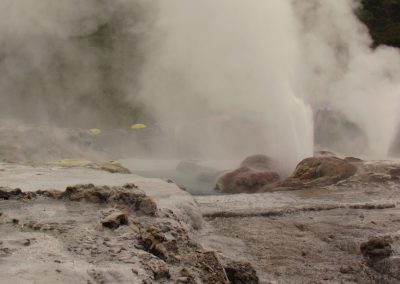
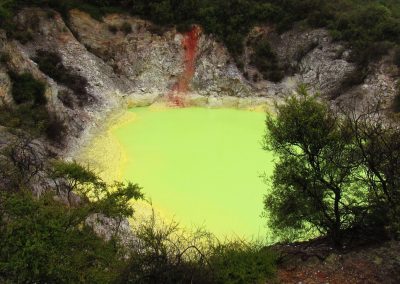
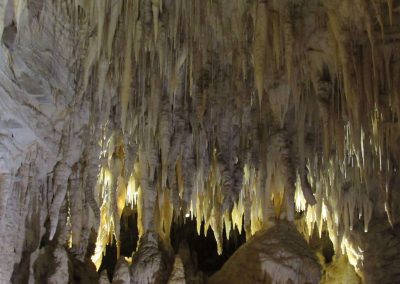
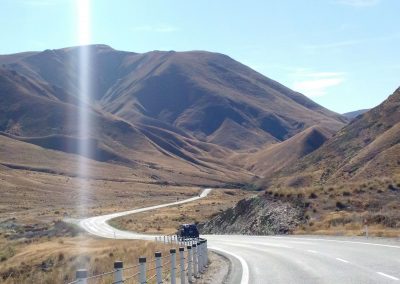

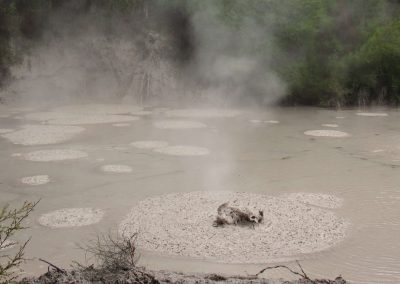

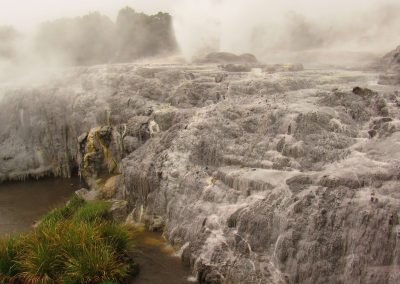
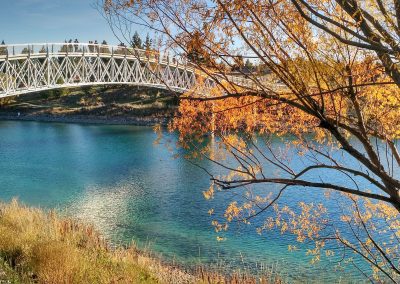

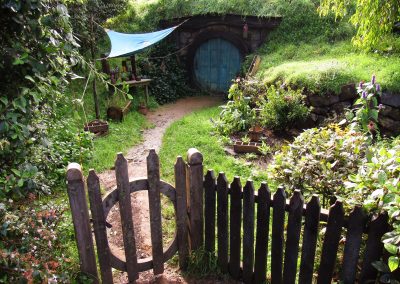
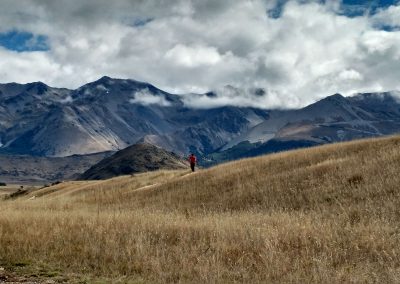
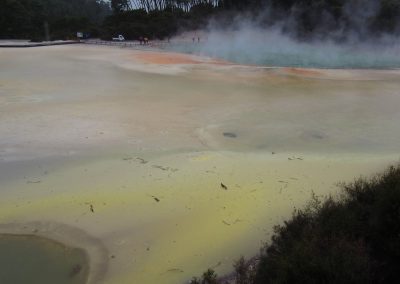
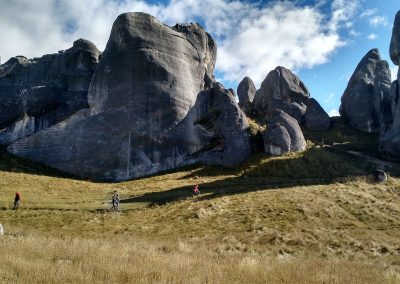
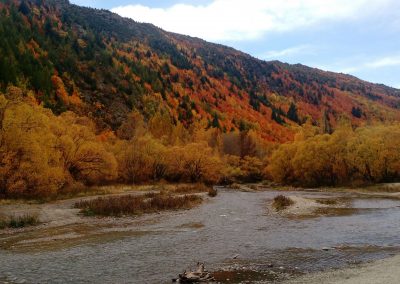

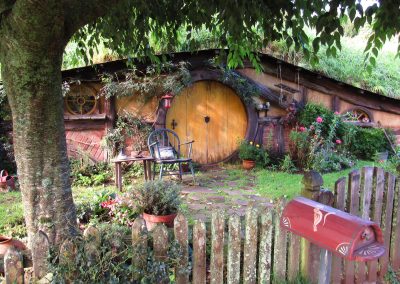
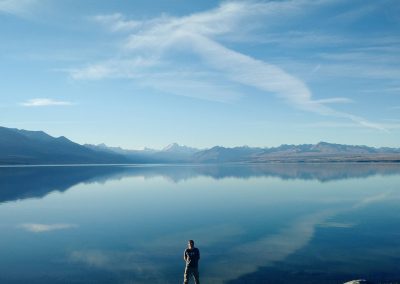
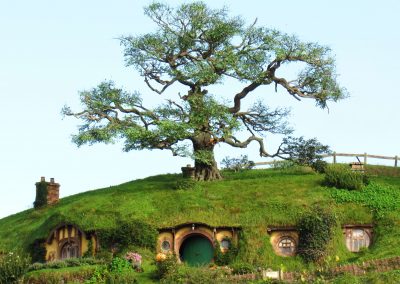
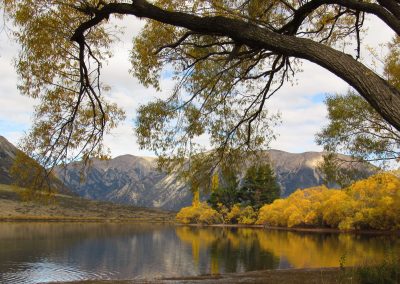
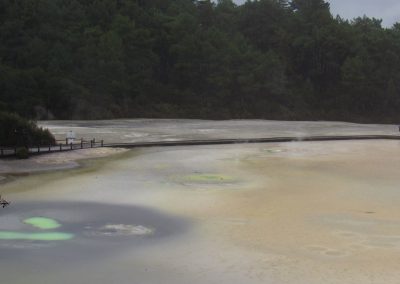
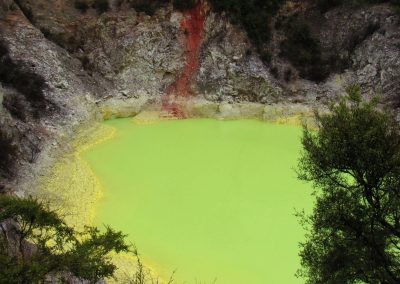

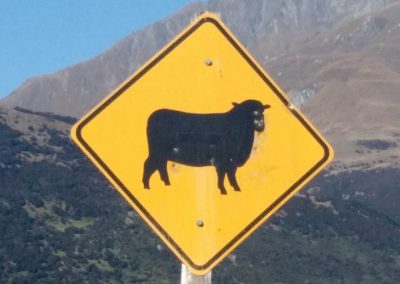

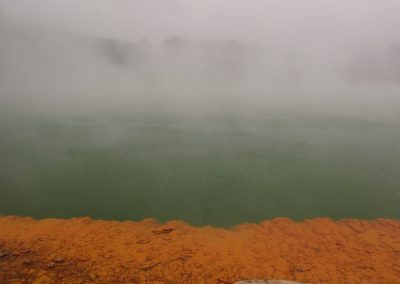
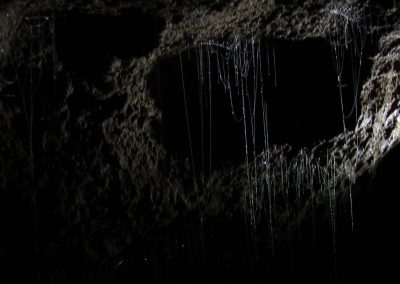


0 comentários